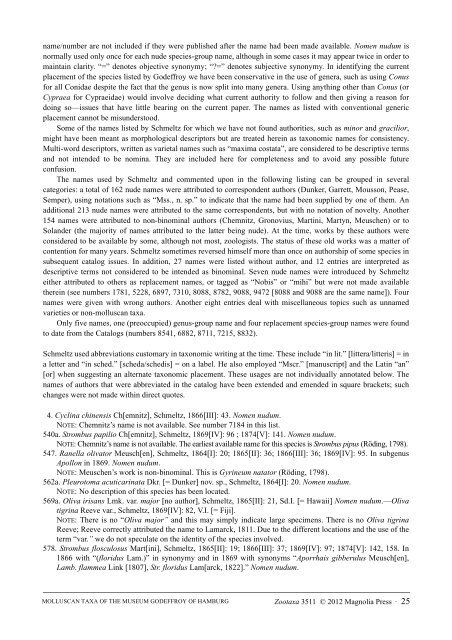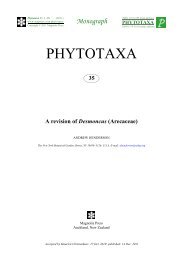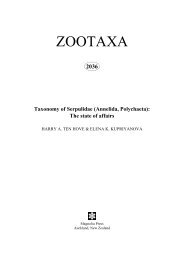Create successful ePaper yourself
Turn your PDF publications into a flip-book with our unique Google optimized e-Paper software.
name/number are not included if they were published after the name had been made available. Nomen nudum is<br />
normally used only once for each nude species-group name, although in some cases it may appear twice in order to<br />
maintain clarity. “=” denotes objective synonymy; “?=” denotes subjective synonymy. In identifying the current<br />
placement of the species listed by Godeffroy we have been conservative in the use of genera, such as using Conus<br />
for all Conidae despite the fact that the genus is now split into many genera. Using anything other than Conus (or<br />
Cypraea for Cypraeidae) would involve deciding what current authority to follow and then giving a reason for<br />
doing so—issues that have little bearing on the current paper. The names as listed with conventional generic<br />
placement cannot be misunderstood.<br />
Some of the names listed by Schmeltz for which we have not found authorities, such as minor and gracilior,<br />
might have been meant as morphological descriptors but are treated herein as taxonomic names for consistency.<br />
Multi-word descriptors, written as varietal names such as “maxima costata”, are considered to be descriptive terms<br />
and not intended to be nomina. They are included here for completeness and to avoid any possible future<br />
confusion.<br />
The names used by Schmeltz and commented upon in the following listing can be grouped in several<br />
categories: a total of 162 nude names were attributed to correspondent authors (Dunker, Garrett, Mousson, Pease,<br />
Semper), using notations such as “Mss., n. sp.” to indicate that the name had been supplied by one of them. An<br />
additional 213 nude names were attributed to the same correspondents, but with no notation of novelty. Another<br />
154 names were attributed to non-binominal authors (Chemnitz, Gronovius, Martini, Martyn, Meuschen) or to<br />
Solander (the majority of names attributed to the latter being nude). At the time, works by these authors were<br />
considered to be available by some, although not most, zoologists. The status of these old works was a matter of<br />
contention for many years. Schmeltz sometimes reversed himself more than once on authorship of some species in<br />
subsequent catalog issues. In addition, 27 names were listed without author, and 12 entries are interpreted as<br />
descriptive terms not considered to be intended as binominal. Seven nude names were introduced by Schmeltz<br />
either attributed to others as replacement names, or tagged as “Nobis” or “mihi” but were not made available<br />
therein (see numbers 1781, 5228, 6897, 7310, 8088, 8782, 9088, 9472 [8088 and 9088 are the same name]). Four<br />
names were given with wrong authors. Another eight entries deal with miscellaneous topics such as unnamed<br />
varieties or non-molluscan taxa.<br />
Only five names, one (preoccupied) genus-group name and four replacement species-group names were found<br />
to date from the Catalogs (numbers 8541, 6882, 8711, 7215, 8832).<br />
Schmeltz used abbreviations customary in taxonomic writing at the time. These include “in lit.” [littera/litteris] = in<br />
a letter and “in sched.” [scheda/schedis] = on a label. He also employed “Mscr.” [manuscript] and the Latin “an”<br />
[or] when suggesting an alternate taxonomic placement. These usages are not individually annotated below. The<br />
names of authors that were abbreviated in the catalog have been extended and emended in square brackets; such<br />
changes were not made within direct quotes.<br />
4. Cyclina chinensis Ch[emnitz], Schmeltz, 1866[III]: 43. Nomen nudum.<br />
NOTE: Chemnitz’s name is not available. See number 7184 in this list.<br />
540a. Strombus papilio Ch[emnitz], Schmeltz, 1869[IV]: 96 ; 1874[V]: 141. Nomen nudum.<br />
NOTE: Chemnitz’s name is not available. The earliest available name for this species is Strombus pipus (Röding, 1798).<br />
547. Ranella olivator Meusch[en], Schmeltz, 1864[I]: 20; 1865[II]: 36; 1866[III]: 36; 1869[IV]: 95. In subgenus<br />
Apollon in 1869. Nomen nudum.<br />
NOTE: Meuschen’s work is non-binominal. This is Gyrineum natator (Röding, 1798).<br />
562a. Pleurotoma acuticarinata Dkr. [= Dunker] nov. sp., Schmeltz, 1864[I]: 20. Nomen nudum.<br />
NOTE: No description of this species has been located.<br />
569a. Oliva irisans Lmk. var. major [no author], Schmeltz, 1865[II]: 21, Sd.I. [= Hawaii] Nomen nudum.—Oliva<br />
tigrina Reeve var., Schmeltz, 1869[IV]: 82, V.I. [= Fiji].<br />
NOTE: There is no “Oliva major” and this may simply indicate large specimens. There is no Oliva tigrina<br />
Reeve; Reeve correctly attributed the name to Lamarck, 1811. Due to the different locations and the use of the<br />
term “var.” we do not speculate on the identity of the species involved.<br />
578. Strombus flosculosus Mart[ini], Schmeltz, 1865[II]: 19; 1866[III]: 37; 1869[IV]: 97; 1874[V]: 142, 158. In<br />
1866 with “(floridus Lam.)” in synonymy and in 1869 with synonyms “Aporrhais gibberulus Meusch[en],<br />
Lamb. flammea Link [1807], Str. floridus Lam[arck, 1822].” Nomen nudum.<br />
MOLLUSCAN TAXA OF THE MUSEUM GODEFFROY OF HAMBURG<br />
Zootaxa 3511 © 2012 <strong>Magnolia</strong> <strong>Press</strong> · 25
















